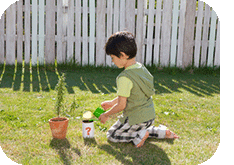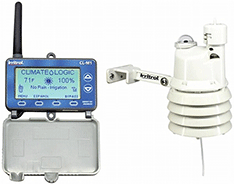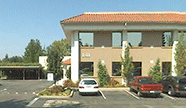7 Practical Tips for Residential Landscapes
Author: Chad Kennedy, Landscape Architect, ASLA
 Over the years, as a horticulturist and landscape architect, I have been approached by many homeowners with inquires related to their struggling yards and gardens. A few of the many questions I have fielded include, "What is wrong with my trees and plants?", "How much water is too much water?", "What can I do to minimize maintenance?", and, "How do I keep my Venus Fly Trap alive?" With the exception of the Venus Fly Trap question, these questions are quite common. In response to these questions the following seven tips have been prepared as general tips for residential landscapes. When followed and implemented they should aid in the effort to keep plants in general health, avoid issues with seasonal watering needs, and minimize overly intense maintenance requirements.
Over the years, as a horticulturist and landscape architect, I have been approached by many homeowners with inquires related to their struggling yards and gardens. A few of the many questions I have fielded include, "What is wrong with my trees and plants?", "How much water is too much water?", "What can I do to minimize maintenance?", and, "How do I keep my Venus Fly Trap alive?" With the exception of the Venus Fly Trap question, these questions are quite common. In response to these questions the following seven tips have been prepared as general tips for residential landscapes. When followed and implemented they should aid in the effort to keep plants in general health, avoid issues with seasonal watering needs, and minimize overly intense maintenance requirements.
Tip#1 - Know the mature size of the plant you buy.
Avoid impulse shopping at the nursery. It can be disastrous. That seemingly perfect little plant in a one or five gallon plant is merely a snap shot in the early life of that plant. It will most likely be much larger, and may even have more woody characteristics. Choose plants based on their mature sizes and appearance as listed in plant reference books (i.e. Sunset Western Garden Book)or websites. The landscape may not appear "filled in" for the first couple of years. However, in the long-term there are benefits from reduced shearing, pruning and plant removal.
Tip#2 - Locate plants according to their need for sunlight.
Similar to people, some plants burn quickly in the sun while others have little issue with extended exposure to the sun. Choosing plants for appropriate locations in the yard and garden greatly increases the chances of healthy growth. Plants with north and east solar exposure should generally tolerate or prefer shade as they will receive the least sunlight. Plants with south and west solar exposure should be tolerant or prefer full sun as these areas will be exposed to sunlight for most of the day. A shade loving plant in full sun will exhibit symptoms of sun scald regardless of how much water it is provided. A sun loving plant in full shade may appear scraggly, potentially discolored and unhealthy.
Tip#3 - Grow a lawn with mixed grass species.
It is often tough to keep a grass lawn looking its best when there are so many variables within large areas of a monoculture landscape. Variables may include differences in sunlight exposure (shaded by trees or structures), grade changes (mounds and low spots), soil nutrient levels and health (particularly in urban environments) and use or traffic impacts (heavily used areas). Different species of grasses are better than others at reacting to environmental variables. Using a seed mix that incorporates several species of grasses will allow the lawn to evolve over time. The species that match the environmental conditions best will be dominant and healthy. The species that do not do as well will eventually disappear. Though there will be a slightly different look to the lawn in different areas, this approach will help avoid thin patches and wear patterns in the lawn.
Tip#4 - Do not mix planting beds with plants of significantly different water requirements. Many issues arise when plants that require little water are mixed in beds with plants that require regular application of water. By separating plants into zones of similar water requirements issues such as fungus and mildew infection, nutrient loss through leaching and over-watering can be avoided. Each of these plant groupings should be irrigated on a separate zone so adjustments to each differing water zone can be easily made. This also applies to areas of lawn that may require more water than others such as the top of mounds or areas of full sun exposure.
 Tip#5 - Install a weather based controller and sensor.
Automated irrigation control has never been easier to implement in residential landscapes. For minimal cost ($50-$75) weather sensors can be added to residential grade controllers. These sensors monitor temperature, solar radiation and rainfall and are programmed with historic evapotranspiration data. Using this data and complicated mathematical equations, the controller adjusts daily watering schedules up or down to match actual water needs. The result of this is appropriate water application throughout the entire year which saves money, saves water and avoids issues with overwatering as already discussed.
Tip#5 - Install a weather based controller and sensor.
Automated irrigation control has never been easier to implement in residential landscapes. For minimal cost ($50-$75) weather sensors can be added to residential grade controllers. These sensors monitor temperature, solar radiation and rainfall and are programmed with historic evapotranspiration data. Using this data and complicated mathematical equations, the controller adjusts daily watering schedules up or down to match actual water needs. The result of this is appropriate water application throughout the entire year which saves money, saves water and avoids issues with overwatering as already discussed.
Tip#6 - Install weed fabric and 3" of mulch.
Though the use of weed fabric in public spaces or areas regularly disturbed (i.e. annual beds / vegetable gardens) is not recommended, it is highly recommended for residential landscapes where limited maintenance is desired. Only weed fabrics that are water permeable should be used and applied in areas that will not require frequent soil disruption. Weed fabric covered with an ample 3" layer of decorative mulch is an unmistakably effective method for reducing weed maintenance and greatly reduce the amount of water lost from the soil surface. Over time weeds may grow in this layer of mulch, however, they are very easily removed as their roots only extend down to the fabric and have little material for stabilization.
Tip#7 - Bold, large curves are best.
Curved features add great interest and character to the landscape. The use of them however must be carefully planned. Bold curves with large radii will reduce the need for hard turns and back and forth movements during mowing. The lineal footage of edging and weed whacking increases with the use of tight curves and requires more tight movements. Small curves are also difficult to irrigate and lead to inefficient water application. Ultimately, large curves are more pleasant to the eye and much more efficient to maintain.
Realistically, entire articles and research projects can be dedicated to each of these tips just presented. Hopefully this short introduction will provide a general starting point towards understanding the framework for a healthier, efficiently watered, and easily maintained outdoor space. Now go out and give some of these a try!
 Over the years, as a horticulturist and landscape architect, I have been approached by many homeowners with inquires related to their struggling yards and gardens. A few of the many questions I have fielded include, "What is wrong with my trees and plants?", "How much water is too much water?", "What can I do to minimize maintenance?", and, "How do I keep my Venus Fly Trap alive?" With the exception of the Venus Fly Trap question, these questions are quite common. In response to these questions the following seven tips have been prepared as general tips for residential landscapes. When followed and implemented they should aid in the effort to keep plants in general health, avoid issues with seasonal watering needs, and minimize overly intense maintenance requirements.
Over the years, as a horticulturist and landscape architect, I have been approached by many homeowners with inquires related to their struggling yards and gardens. A few of the many questions I have fielded include, "What is wrong with my trees and plants?", "How much water is too much water?", "What can I do to minimize maintenance?", and, "How do I keep my Venus Fly Trap alive?" With the exception of the Venus Fly Trap question, these questions are quite common. In response to these questions the following seven tips have been prepared as general tips for residential landscapes. When followed and implemented they should aid in the effort to keep plants in general health, avoid issues with seasonal watering needs, and minimize overly intense maintenance requirements.
 Tip#5 - Install a weather based controller and sensor.
Automated irrigation control has never been easier to implement in residential landscapes. For minimal cost ($50-$75) weather sensors can be added to residential grade controllers. These sensors monitor temperature, solar radiation and rainfall and are programmed with historic evapotranspiration data. Using this data and complicated mathematical equations, the controller adjusts daily watering schedules up or down to match actual water needs. The result of this is appropriate water application throughout the entire year which saves money, saves water and avoids issues with overwatering as already discussed.
Tip#5 - Install a weather based controller and sensor.
Automated irrigation control has never been easier to implement in residential landscapes. For minimal cost ($50-$75) weather sensors can be added to residential grade controllers. These sensors monitor temperature, solar radiation and rainfall and are programmed with historic evapotranspiration data. Using this data and complicated mathematical equations, the controller adjusts daily watering schedules up or down to match actual water needs. The result of this is appropriate water application throughout the entire year which saves money, saves water and avoids issues with overwatering as already discussed.

